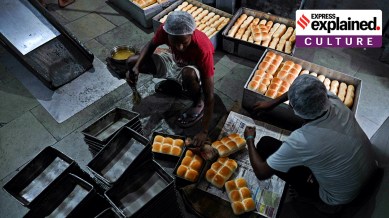Story of Mumbai’s humble ‘ladi pav’, and why its price may soon go up
The ladi pav came to India with the Portuguese in the 16th century, when they established a colony in Goa. “Pão” in Portuguese means “bread”.

The Maharashtra Pollution Control Board last month issued show-cause notices to 287 bakeries in Mumbai, including the iconic Yazdani Bakery in the Fort area of South Mumbai.
The notices were issued after civic authorities throughout last year pushed bakeries in the metropolis to switch from wood to gas or electricity. A study titled ‘Envisioning a Sustainable Bakery Industry for Mumbai’ published in 2024 by the Bombay Environmental Action Group found that just 72 surveyed bakeries generated more than 80,000 kg of PM 2.5 pollution, and almost 120,000 kg of PM10 pollution annually.
monthly limit of free stories.
with an Express account.
But a switch to gas or electric ovens will likely result in a hike in the prices of Mumbai’s beloved ladi pav, a bread that has long been a staple for the city and its working classes.
Pão to pav
The ladi pav came to India with the Portuguese in the 16th century, when they established a colony in Goa. “Pão” in Portuguese means “bread”.
“Wherever people from Portuguese territories migrated, this bread travelled with them. So when Goans moved to Bombay, they set up Goan bakeries and started making pav. Muslim and Irani bakers followed suit, and pav became a staple for working-class Mumbaikars,” Kurush Dalal, a Mumbai-based archaeologist, historian, and culinary anthropologist, told The Indian Express.
Such was the pav’s popularity that in the 1970s and 1980s, the government sold maida directly to bakeries at a subsidised price to prevent “unrest” due to bread shortages, Dalal said.
(Express photo by Sankhadeep Banerjee)
Addition to native dishes
Over time, the versatile bread became an intrinsic part of Mumbai’s food culture, pairing well with curries, keema, and bhurji, or simply eaten with tea.
Pav bhaji, a quintessential Mumbai staple, is said to have emerged during the American Civil War (1861-65). As the supply of slave-picked American cotton dried up, Britain turned to India to offset shortages. As manufacturing was ramped up in Bombay, pav bhaji emerged as a convenient meal for mill workers.
The vada pav, on the other hand, appeared in the late 1960s. At the time, the batata vada — a spiced potato filling dipped in chickpea batter and deep-fried — was already a popular Maharashtrian snack.
Dalal tells the apocryphal story of vada pav’s invention:
“A street vendor named Ashok Vaidya sold batata vadas from a cart outside Dadar station. Many customers struggled to carry hot vadas while catching trains, and cold vadas weren’t half as delicious as hot ones. Next to him was a vendor selling omelettes with pav for breakfast. One day, after an epiphany, Vaidya grabbed some pavs from his neighbour and started stuffing the vadas inside them. And that’s how vada pav was born.”
The combination of a vada and a pav became an instant hit. It was both affordable and filling, something that catered to students, migrants, and mill workers alike. Even today, a Mumbai vada pav can cost as little as Rs 10.
The vada pav has also attracted political attention. At a time when Udupi restaurants offering inexpensive vegetarian meals were flourishing in Mumbai 1960s-70s, the late Balasaheb Thackeray, founder of the Shiv Sena, positioned vada pav stalls as the local alternative to South Indian establishments run by “outsiders”. In fact, the party even introduced a scheme that allowed laid-off factory workers to set up vada pav stalls for a nominal amount, bypassing all licensing requirements. Decades later in 2009, Thackeray’s party launched Shiv Vada, a chain of vada pav stalls, although this enterprise saw limited success.
Impending price rise
Soon, the vada pav may not be as cheap as it is today.
Omaish Siddiqui, of the New Edward Bakery in the Fort area, said running a wood-fired oven is cheaper for bakeries. “Wood costs Rs 6 per kg, and we use about 200 kg a day, bringing our fuel cost to Rs 1,000-1,200. Switching to electricity would significantly increase our costs, and thus make our products more expensive,” he said, adding that LPG was not feasible as the area did not have a gas connection.
Siddiqui also pointed to broader financial pressures: “The price of maida has increased significantly over the years, and even yeast has become more expensive. On top of that, labour costs continue to rise. Despite all this, we’ve kept the price of ladi pav steady.”
The New Edward Bakery sells ladi pav at Rs 12 per loaf (six pavs) for wholesale buyers purchasing more than 50 packets, and Rs 15 for retail customers. His wholesale clients include the India Government Mint, the RBI, Central Railways, and cycle vendors who deliver these loafs door-to-door.
“Even with subsidies, we’ll have no choice but to raise the price of ladi pav by at least Rs 2-3 per loaf,” said Nasir Ansari, President of The Bombay Bakers Association.
He said, “that means the wholesale price will rise to Rs 14-15 per loaf, increasing the cost of each pav by at least Rs 1. As a result, vada pav, which currently sells for Rs 15, may go up to Rs 20. In the end, it’s the common man who will bear the cost.”